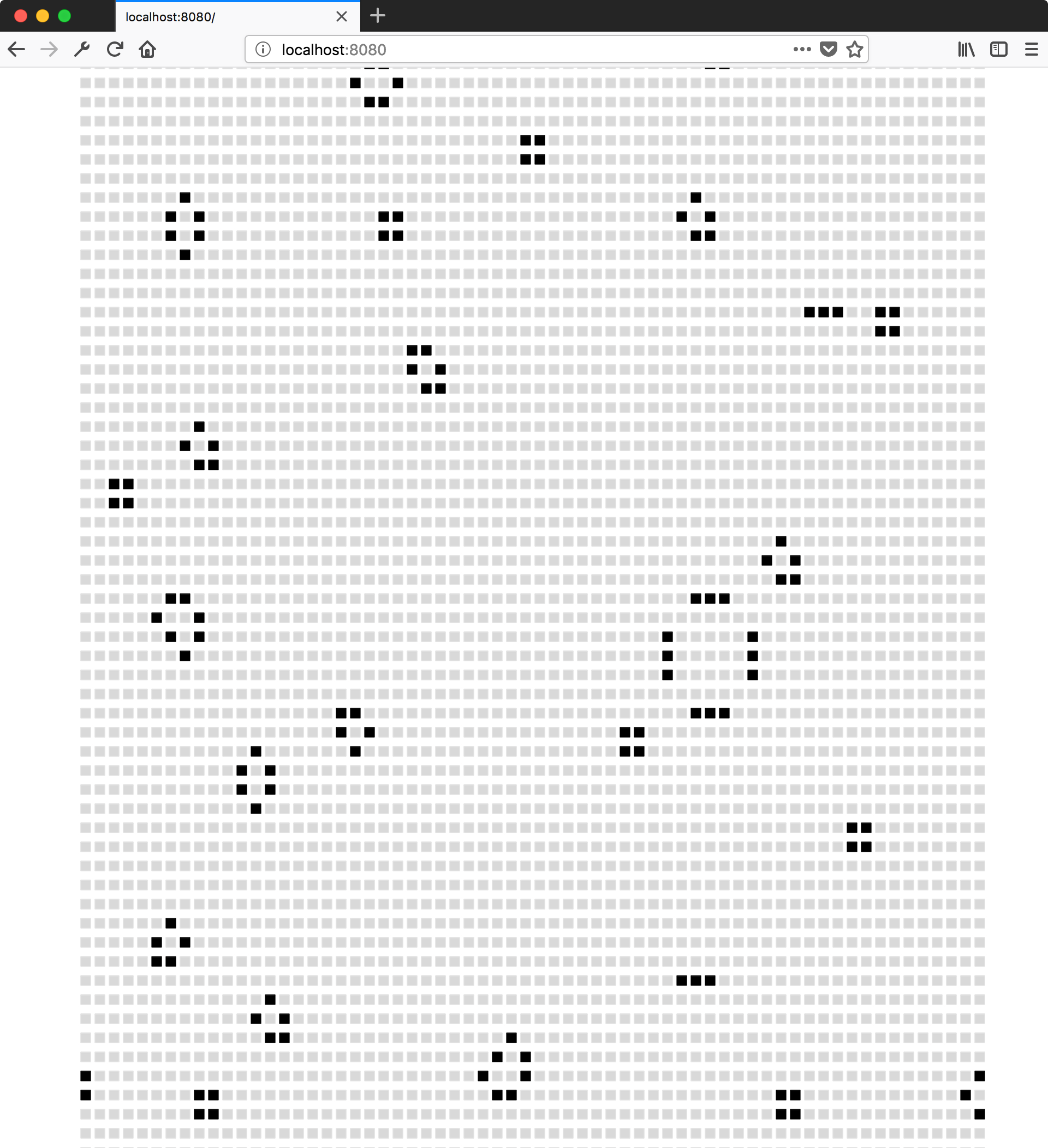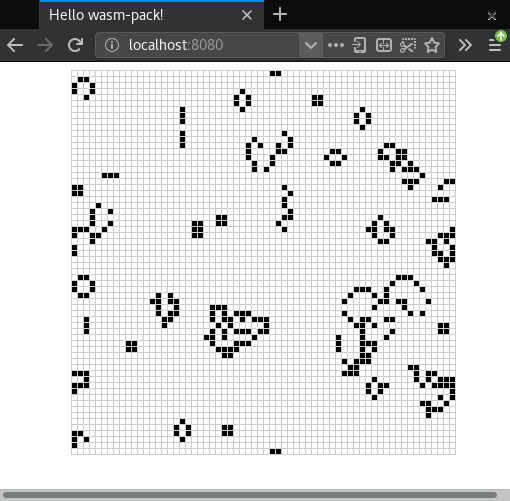实现康威的生命游戏
设计
在我们深入研究之前,我们需要考虑一些设计选择。
无限宇宙
生命游戏在一个无限的宇宙中进行,但我们没有无限的内存和计算能力。解决这个相当令人讨厌的限制通常有三种方法
-
跟踪宇宙中发生有趣事情的子集,并根据需要扩展这个区域。在最坏的情况下,这种扩展是无界的,实现将变得越来越慢,最终耗尽内存。
-
创建一个固定大小的宇宙,其中边缘的细胞比中间的细胞邻居更少。这种方法的缺点是,无限模式(如滑翔机)到达宇宙边缘时会被消灭。
-
创建一个固定大小的周期性宇宙,其中边缘的细胞的邻居会环绕到宇宙的另一侧。由于邻居会环绕宇宙边缘,滑翔机可以永远运行。
我们将实现第三种选择。
Rust 和 JavaScript 的接口
⚡ 这是本教程中最重要的概念之一,需要理解和掌握!
JavaScript 的垃圾回收堆(Object、Array 和 DOM 节点在其中分配)与 WebAssembly 的线性内存空间不同,我们的 Rust 值就存在于线性内存空间中。WebAssembly 目前无法直接访问垃圾回收堆(截至 2018 年 4 月,预计这将随着 "接口类型"提案 的发布而改变)。另一方面,JavaScript 可以读写 WebAssembly 线性内存空间,但只能作为 ArrayBuffer 的标量值(u8、i32、f64 等)。WebAssembly 函数也接受和返回标量值。这些是构成所有 WebAssembly 和 JavaScript 通信的基本要素。
wasm_bindgen 定义了跨越此边界处理复合结构的通用理解。它涉及对 Rust 结构进行装箱,并将指针包装在 JavaScript 类中以方便使用,或者从 Rust 索引到 JavaScript 对象表中。wasm_bindgen 非常方便,但它并没有消除考虑数据表示的必要性,以及哪些值和结构跨越此边界传递。相反,将其视为实现你选择的接口设计的工具。
在设计 WebAssembly 和 JavaScript 之间的接口时,我们希望优化以下属性
-
最大程度地减少对 WebAssembly 线性内存的复制。 不必要的复制会带来不必要的开销。
-
最大程度地减少序列化和反序列化。 与复制类似,序列化和反序列化也会带来开销,并且通常也会带来复制。如果我们可以传递数据结构的不透明句柄(而不是在一侧序列化它,将其复制到 WebAssembly 线性内存中的某个已知位置,并在另一侧反序列化它),我们通常可以减少很多开销。
wasm_bindgen帮助我们定义和处理对 JavaScriptObject或装箱的 Rust 结构的不透明句柄。
作为一个通用的经验法则,一个好的 JavaScript↔WebAssembly 接口设计通常是将大型、长寿命的数据结构实现为存在于 WebAssembly 线性内存中的 Rust 类型,并将其作为不透明句柄公开给 JavaScript。JavaScript 调用导出的 WebAssembly 函数,这些函数接受这些不透明句柄,转换其数据,执行繁重的计算,查询数据,并最终返回一个小的、可复制的结果。通过只返回计算的小结果,我们避免了在 JavaScript 垃圾回收堆和 WebAssembly 线性内存之间来回复制和/或序列化所有内容。
在我们的生命游戏中,Rust 和 JavaScript 的接口
让我们从列举一些要避免的危险开始。我们不想在每次滴答时将整个宇宙复制进出 WebAssembly 线性内存。我们不想为宇宙中的每个细胞分配对象,也不想强加跨边界调用来读取和写入每个细胞。
这让我们剩下什么?我们可以将宇宙表示为一个存在于 WebAssembly 线性内存中的扁平数组,每个细胞对应一个字节。0 代表死细胞,1 代表活细胞。
下面是一个 4x4 宇宙在内存中的样子

要找到宇宙中给定行和列的细胞的数组索引,我们可以使用以下公式
index(row, column, universe) = row * width(universe) + column
我们有几种方法可以将宇宙的细胞暴露给 JavaScript。首先,我们将为 Universe 实现 std::fmt::Display,我们可以用它来生成一个 Rust String,其中细胞以文本字符的形式呈现。然后,这个 Rust String 从 WebAssembly 线性内存复制到 JavaScript 垃圾回收堆中的 JavaScript String,然后通过设置 HTML textContent 来显示。在本章的后面,我们将改进这个实现,以避免在堆之间复制宇宙的细胞,并渲染到 <canvas>。
另一种可行的设计方案是,Rust 在每次滴答后返回一个包含所有状态发生变化的细胞的列表,而不是将整个宇宙暴露给 JavaScript。这样,JavaScript 在渲染时就不需要遍历整个宇宙,只需要遍历相关的子集。权衡的是,这种基于增量的设计实现起来稍微困难一些。
Rust 实现
在上一章中,我们克隆了一个初始项目模板。现在我们将修改这个项目模板。
让我们从 wasm-game-of-life/src/lib.rs 中删除 alert 导入和 greet 函数开始,并用细胞的类型定义替换它们
# #![allow(unused_variables)] #fn main() { #[wasm_bindgen] #[repr(u8)] #[derive(Clone, Copy, Debug, PartialEq, Eq)] pub enum Cell { Dead = 0, Alive = 1, } #}
重要的是,我们有 #[repr(u8)],这样每个细胞都表示为一个字节。同样重要的是,Dead 变体是 0,Alive 变体是 1,这样我们就可以很容易地通过加法来计算一个细胞的活邻居。
接下来,让我们定义宇宙。宇宙有宽度和高度,以及一个长度为 width * height 的细胞向量。
# #![allow(unused_variables)] #fn main() { #[wasm_bindgen] pub struct Universe { width: u32, height: u32, cells: Vec<Cell>, } #}
要访问给定行和列的细胞,我们将行和列转换为细胞向量中的索引,如前所述
# #![allow(unused_variables)] #fn main() { impl Universe { fn get_index(&self, row: u32, column: u32) -> usize { (row * self.width + column) as usize } // ... } #}
为了计算一个细胞的下一个状态,我们需要获得一个计数,统计有多少邻居是活的。让我们编写一个 live_neighbor_count 方法来完成这个任务!
# #![allow(unused_variables)] #fn main() { impl Universe { // ... fn live_neighbor_count(&self, row: u32, column: u32) -> u8 { let mut count = 0; for delta_row in [self.height - 1, 0, 1].iter().cloned() { for delta_col in [self.width - 1, 0, 1].iter().cloned() { if delta_row == 0 && delta_col == 0 { continue; } let neighbor_row = (row + delta_row) % self.height; let neighbor_col = (column + delta_col) % self.width; let idx = self.get_index(neighbor_row, neighbor_col); count += self.cells[idx] as u8; } } count } } #}
live_neighbor_count 方法使用增量和模运算来避免使用 if 语句对宇宙边缘进行特殊处理。当应用 -1 的增量时,我们添加 self.height - 1 并让模运算发挥作用,而不是尝试减去 1。row 和 column 可以是 0,如果我们尝试从它们中减去 1,就会发生无符号整数下溢。
现在我们拥有了从当前一代计算下一代所需的一切!游戏的每条规则都直接转化为match表达式中的条件。此外,因为我们希望JavaScript控制何时发生滴答,所以我们将此方法放在#[wasm_bindgen]块中,以便它暴露给JavaScript。
# #![allow(unused_variables)] #fn main() { /// Public methods, exported to JavaScript. #[wasm_bindgen] impl Universe { pub fn tick(&mut self) { let mut next = self.cells.clone(); for row in 0..self.height { for col in 0..self.width { let idx = self.get_index(row, col); let cell = self.cells[idx]; let live_neighbors = self.live_neighbor_count(row, col); let next_cell = match (cell, live_neighbors) { // Rule 1: Any live cell with fewer than two live neighbours // dies, as if caused by underpopulation. (Cell::Alive, x) if x < 2 => Cell::Dead, // Rule 2: Any live cell with two or three live neighbours // lives on to the next generation. (Cell::Alive, 2) | (Cell::Alive, 3) => Cell::Alive, // Rule 3: Any live cell with more than three live // neighbours dies, as if by overpopulation. (Cell::Alive, x) if x > 3 => Cell::Dead, // Rule 4: Any dead cell with exactly three live neighbours // becomes a live cell, as if by reproduction. (Cell::Dead, 3) => Cell::Alive, // All other cells remain in the same state. (otherwise, _) => otherwise, }; next[idx] = next_cell; } } self.cells = next; } // ... } #}
到目前为止,宇宙的状态被表示为一个细胞向量。为了使它对人类可读,让我们实现一个基本的文本渲染器。我们的想法是将宇宙逐行地写成文本,对于每个活着的细胞,打印Unicode字符◼(“黑色中等正方形”)。对于死细胞,我们将打印◻(“白色中等正方形”)。
通过实现Rust标准库中的Display特征,我们可以添加一种以面向用户的方式格式化结构的方法。这也会自动为我们提供一个to_string方法。
# #![allow(unused_variables)] #fn main() { use std::fmt; impl fmt::Display for Universe { fn fmt(&self, f: &mut fmt::Formatter) -> fmt::Result { for line in self.cells.as_slice().chunks(self.width as usize) { for &cell in line { let symbol = if cell == Cell::Dead { '◻' } else { '◼' }; write!(f, "{}", symbol)?; } write!(f, "\n")?; } Ok(()) } } #}
最后,我们定义一个构造函数,它用一个有趣的活细胞和死细胞模式初始化宇宙,以及一个render方法。
# #![allow(unused_variables)] #fn main() { /// Public methods, exported to JavaScript. #[wasm_bindgen] impl Universe { // ... pub fn new() -> Universe { let width = 64; let height = 64; let cells = (0..width * height) .map(|i| { if i % 2 == 0 || i % 7 == 0 { Cell::Alive } else { Cell::Dead } }) .collect(); Universe { width, height, cells, } } pub fn render(&self) -> String { self.to_string() } } #}
有了这些,我们生命游戏实现的Rust部分就完成了!
通过在wasm-game-of-life目录中运行wasm-pack build来将其重新编译为WebAssembly。
使用JavaScript渲染
首先,让我们在wasm-game-of-life/www/index.html中添加一个<pre>元素,将宇宙渲染到其中,就在<script>标签的上面。
<body>
<pre id="game-of-life-canvas"></pre>
<script src="./bootstrap.js"></script>
</body>
此外,我们希望<pre>居中在网页的中间。我们可以使用CSS弹性盒子来完成这项任务。在wasm-game-of-life/www/index.html的<head>中添加以下<style>标签。
<style>
body {
position: absolute;
top: 0;
left: 0;
width: 100%;
height: 100%;
display: flex;
flex-direction: column;
align-items: center;
justify-content: center;
}
</style>
在wasm-game-of-life/www/index.js的顶部,让我们修复我们的导入,引入Universe而不是旧的greet函数。
import { Universe } from "wasm-game-of-life";
另外,让我们获取我们刚刚添加的<pre>元素,并实例化一个新的宇宙。
const pre = document.getElementById("game-of-life-canvas");
const universe = Universe.new();
JavaScript在一个requestAnimationFrame循环中运行。在每次迭代中,它将当前宇宙绘制到<pre>中,然后调用Universe::tick。
const renderLoop = () => {
pre.textContent = universe.render();
universe.tick();
requestAnimationFrame(renderLoop);
};
要启动渲染过程,我们只需要对渲染循环的第一次迭代进行初始调用。
requestAnimationFrame(renderLoop);
确保你的开发服务器仍在运行(在wasm-game-of-life/www中运行npm run start),这就是https://:8080/的样子。
直接从内存渲染到画布
在Rust中生成(并分配)一个String,然后让wasm-bindgen将其转换为有效的JavaScript字符串,会导致对宇宙细胞的不必要复制。由于JavaScript代码已经知道宇宙的宽度和高度,并且可以直接读取构成细胞的WebAssembly线性内存,因此我们将修改render方法,使其返回指向细胞数组开头的指针。
此外,我们将不再渲染Unicode文本,而是切换到使用Canvas API。我们将在本教程的其余部分使用这种设计。
在wasm-game-of-life/www/index.html中,让我们用一个<canvas>替换我们之前添加的<pre>,我们将渲染到其中(它也应该在<body>中,在加载我们JavaScript的<script>之前)。
<body>
<canvas id="game-of-life-canvas"></canvas>
<script src='./bootstrap.js'></script>
</body>
为了从Rust实现中获取必要的信息,我们需要为宇宙的宽度、高度及其细胞数组的指针添加一些获取函数。所有这些都暴露给JavaScript。将这些添加内容添加到wasm-game-of-life/src/lib.rs中。
# #![allow(unused_variables)] #fn main() { /// Public methods, exported to JavaScript. #[wasm_bindgen] impl Universe { // ... pub fn width(&self) -> u32 { self.width } pub fn height(&self) -> u32 { self.height } pub fn cells(&self) -> *const Cell { self.cells.as_ptr() } } #}
接下来,在wasm-game-of-life/www/index.js中,让我们也从wasm-game-of-life中导入Cell,并定义一些我们在渲染到画布时将使用的常量。
import { Universe, Cell } from "wasm-game-of-life";
const CELL_SIZE = 5; // px
const GRID_COLOR = "#CCCCCC";
const DEAD_COLOR = "#FFFFFF";
const ALIVE_COLOR = "#000000";
现在,让我们重写这段JavaScript代码的其余部分,不再写入<pre>的textContent,而是绘制到<canvas>中。
// Construct the universe, and get its width and height.
const universe = Universe.new();
const width = universe.width();
const height = universe.height();
// Give the canvas room for all of our cells and a 1px border
// around each of them.
const canvas = document.getElementById("game-of-life-canvas");
canvas.height = (CELL_SIZE + 1) * height + 1;
canvas.width = (CELL_SIZE + 1) * width + 1;
const ctx = canvas.getContext('2d');
const renderLoop = () => {
universe.tick();
drawGrid();
drawCells();
requestAnimationFrame(renderLoop);
};
为了在细胞之间绘制网格,我们绘制一组等间距的水平线,以及一组等间距的垂直线。这些线交叉形成网格。
const drawGrid = () => {
ctx.beginPath();
ctx.strokeStyle = GRID_COLOR;
// Vertical lines.
for (let i = 0; i <= width; i++) {
ctx.moveTo(i * (CELL_SIZE + 1) + 1, 0);
ctx.lineTo(i * (CELL_SIZE + 1) + 1, (CELL_SIZE + 1) * height + 1);
}
// Horizontal lines.
for (let j = 0; j <= height; j++) {
ctx.moveTo(0, j * (CELL_SIZE + 1) + 1);
ctx.lineTo((CELL_SIZE + 1) * width + 1, j * (CELL_SIZE + 1) + 1);
}
ctx.stroke();
};
我们可以通过memory直接访问WebAssembly的线性内存,它在原始wasm模块wasm_game_of_life_bg中定义。为了绘制细胞,我们获取指向宇宙细胞的指针,构造一个覆盖细胞缓冲区的Uint8Array,遍历每个细胞,并根据细胞是死还是活分别绘制一个白色或黑色的矩形。通过使用指针和覆盖,我们避免了在每次滴答时跨越边界复制细胞。
// Import the WebAssembly memory at the top of the file.
import { memory } from "wasm-game-of-life/wasm_game_of_life_bg";
// ...
const getIndex = (row, column) => {
return row * width + column;
};
const drawCells = () => {
const cellsPtr = universe.cells();
const cells = new Uint8Array(memory.buffer, cellsPtr, width * height);
ctx.beginPath();
for (let row = 0; row < height; row++) {
for (let col = 0; col < width; col++) {
const idx = getIndex(row, col);
ctx.fillStyle = cells[idx] === Cell.Dead
? DEAD_COLOR
: ALIVE_COLOR;
ctx.fillRect(
col * (CELL_SIZE + 1) + 1,
row * (CELL_SIZE + 1) + 1,
CELL_SIZE,
CELL_SIZE
);
}
}
ctx.stroke();
};
要启动渲染过程,我们将使用与上面相同的代码来启动渲染循环的第一次迭代。
drawGrid();
drawCells();
requestAnimationFrame(renderLoop);
请注意,我们在这里在调用requestAnimationFrame()之前调用drawGrid()和drawCells()。我们这样做的原因是,这样宇宙的初始状态就会在我们进行修改之前绘制出来。如果我们只是简单地调用requestAnimationFrame(renderLoop),我们最终会遇到这样的情况:绘制的第一帧实际上是在第一次调用universe.tick()之后,也就是这些细胞生命的第二次“滴答”。
它起作用了!
通过在根wasm-game-of-life目录中运行以下命令来重建WebAssembly和绑定胶水。
wasm-pack build
确保你的开发服务器仍在运行。如果它没有运行,请从wasm-game-of-life/www目录中重新启动它。
npm run start
如果你刷新https://:8080/,你应该会看到一个令人兴奋的生命展示!
顺便说一句,还有一种非常巧妙的算法可以实现生命游戏,叫做hashlife。它使用积极的记忆,实际上可以随着运行时间的推移而变得指数级地更快来计算未来的世代!鉴于此,你可能想知道为什么我们没有在本教程中实现hashlife。它超出了本文的范围,我们专注于Rust和WebAssembly的集成,但我们强烈建议你自行学习hashlife!
练习
-
用一艘宇宙飞船初始化宇宙。
-
不要硬编码初始宇宙,而是生成一个随机的宇宙,其中每个细胞都有50%的概率是活的或死的。
提示:使用
js-syscrate导入Math.randomJavaScript函数。答案
首先,在wasm-game-of-life/Cargo.toml中添加js-sys作为依赖项。# ... [dependencies] js-sys = "0.3" # ...然后,使用
js_sys::Math::random函数来抛硬币。# #![allow(unused_variables)] #fn main() { extern crate js_sys; // ... if js_sys::Math::random() < 0.5 { // Alive... } else { // Dead... } #} -
用一个字节表示每个细胞使遍历细胞变得容易,但它以浪费内存为代价。每个字节有八位,但我们只需要一位来表示每个细胞是活的还是死的。重构数据表示,以便每个细胞只使用一位空间。
答案
在Rust中,你可以使用
fixedbitsetcrate及其FixedBitSet类型来表示细胞,而不是Vec<Cell>。# #![allow(unused_variables)] #fn main() { // Make sure you also added the dependency to Cargo.toml! extern crate fixedbitset; use fixedbitset::FixedBitSet; // ... #[wasm_bindgen] pub struct Universe { width: u32, height: u32, cells: FixedBitSet, } #}宇宙构造函数可以按以下方式调整。
# #![allow(unused_variables)] #fn main() { pub fn new() -> Universe { let width = 64; let height = 64; let size = (width * height) as usize; let mut cells = FixedBitSet::with_capacity(size); for i in 0..size { cells.set(i, i % 2 == 0 || i % 7 == 0); } Universe { width, height, cells, } } #}要更新宇宙下一次滴答中的细胞,我们使用
FixedBitSet的set方法。# #![allow(unused_variables)] #fn main() { next.set(idx, match (cell, live_neighbors) { (true, x) if x < 2 => false, (true, 2) | (true, 3) => true, (true, x) if x > 3 => false, (false, 3) => true, (otherwise, _) => otherwise }); #}要将指向位开头的指针传递给JavaScript,你可以将
FixedBitSet转换为切片,然后将切片转换为指针。# #![allow(unused_variables)] #fn main() { #[wasm_bindgen] impl Universe { // ... pub fn cells(&self) -> *const u32 { self.cells.as_slice().as_ptr() } } #}在JavaScript中,从Wasm内存构造
Uint8Array与以前相同,只是数组的长度不再是width * height,而是width * height / 8,因为我们每位有一个细胞,而不是每个字节有一个细胞。const cells = new Uint8Array(memory.buffer, cellsPtr, width * height / 8);给定一个索引和
Uint8Array,你可以使用以下函数确定第n位是否被设置。const bitIsSet = (n, arr) => { const byte = Math.floor(n / 8); const mask = 1 << (n % 8); return (arr[byte] & mask) === mask; };有了这一切,新的
drawCells版本看起来像这样。const drawCells = () => { const cellsPtr = universe.cells(); // This is updated! const cells = new Uint8Array(memory.buffer, cellsPtr, width * height / 8); ctx.beginPath(); for (let row = 0; row < height; row++) { for (let col = 0; col < width; col++) { const idx = getIndex(row, col); // This is updated! ctx.fillStyle = bitIsSet(idx, cells) ? ALIVE_COLOR : DEAD_COLOR; ctx.fillRect( col * (CELL_SIZE + 1) + 1, row * (CELL_SIZE + 1) + 1, CELL_SIZE, CELL_SIZE ); } } ctx.stroke(); };

